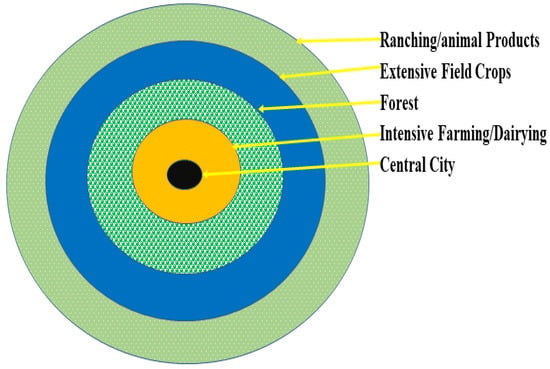Urban agriculture attempts to advance sustainable agricultural methods, such as composting, the use of organic fertilizers, and water conservation. It involves a multidisciplinary approach, combining knowledge of soil science, plant physiology, sustainable agriculture, and technology. Crop rotation and companion planting are two other methods urban farmers can utilize to lessen the demand for pesticides and herbicides. The crops are managed using advanced technology involving sensor-based monitoring, automated irrigation systems, and data analysis to maximize crop output. Urban crop farming is regarded as an important agricultural activity for the modern and circular economy, as it can also improve the urban residents’ income and reduce agricultural waste and gaseous emissions from long-distance transportation.
- urban farming
- hydroponics
- aquaponics
1. Introduction
2. Theory of Urban Farming

References
- Henne, B. How Far Did Your Food Travel to Get to You? Michigan State University, MSU Extension. 2012. Available online: https://www.canr.msu.edu/news/how_far_did_your_food_travel_to_get_to_you (accessed on 10 March 2021).
- Jaggarnath, G. The Transforming City: Exploring the Potential for Smart Cities and Urban Agriculture in Africa. Orient. Anthropol. 2021, 22, 24–40.
- De Preneuf, F. Agriculture and Food. 2021. Available online: https://www.worldbank.org/en/topic/agriculture/ (accessed on 21 December 2022).
- Monaco, T.J.; Weller, S.C.; Ashton, F.M. Weed Science: Principles and Practices, 4th ed.; Pests Diseases & Weeds; Wiley-Blackwell: Hoboken, NJ, USA, 2002; p. 1359. ISBN 978-0-471-37051-2.
- Fennimore, S.A.; Bell, C. Principles of Weed Control, 4th ed.; California Weed Science Society: West Sacramento, CA, USA, 2014.
- Mishra, A. Weed Management: (Agriculture Research Associates), 2nd ed.; Kalyani: New Delhi, India, 2020.
- IPS (International Phytotechnology Society). Book of Abstract. In Proceedings of the 11th International Phytotechnologies Conference, Heraklion, Greece, 30 September–3 October 2014; Kalogerakis, N., Manois, T., Eds.; International Phytotechnology Society: Cincinnati, OH, USA, 2014.
- O’Kelly, M.; Bryan, D. Agricultural location theory: Von Thunen’s contribution to economic geography. Prog. Hum. Geogr. 1996, 20, 457–475.
- Maraseni, T.N.; Qu, J. An international comparison of agricultural nitrous oxide emissions. J. Clean. Prod. 2016, 135, 1256–1266. Available online: https://www.elsevier.com/locate/jclepro (accessed on 21 December 2022).
- Vermuelen, S.J.; Campbell, B.M.; Ingram, J.S.L. Climate change and food systems. Ann. Rev. Environ. Resour. 2012, 37, 195–222.
- Quinton, A. Why Is One-Third of Our Food Wasted Worldwide? Study Examines Causes of Food Waste and Potential Solutions. UC Davis. 1 October 2019. Available online: https://www.ucdavis.edu/food/news/why-is-one-third-of-food-wasted-worldwide (accessed on 22 December 2022).
- WHO. Food Safety. World Health Organization. 19 May 2022. Available online: https://www.who.int/news-room/fact-sheets/detail/food-safety (accessed on 22 December 2022).
- De Lucia, E.H.; Drake, J.E.; Thomas, R.B.; Gonzalez-Meler, M. Forest carbon use efficiency: Is respiration a constant fraction of gross primary production? Glob. Change Biol. 2007, 13, 1157–1167.
- Bradford, M.A.; Crowther, T.W. Carbon use efficiency and storage in terrestrial ecosystems. New Phytol. 2013, 199, 7–9.
- Roxburgh, S.H.; Berry, S.L.; Buckley, T.N.; Barnes, B.; Roderick, M.L. What is NPP? Inconsistent accounting of respiratory fluxes in the definition of net primary production. Funct. Ecol. 2005, 19, 378–382.
- Ballantyne, A.Á.; Alden, C.Á.; Miller, J.Á.; Tans, P.Á.; White, J.W.C. Increase in observed net carbon dioxide uptake by land and oceans during the past 50 years. Nature 2012, 488, 70–72.
- Elias, S.A. Reference Module in Earth Systems and Environmental Sciences; Elsevier: Amsterdam, The Netherlands, 2021; ISBN 0124095488/978012409595489.
- FAO. The State of the World’s Land and Water Resources for Food and Agriculture. Managing System at Risk; Food and Agriculture Organization (FAO): Rome, Italy, 2011.
- Ritchie, H.; Roser, M. Urbanization. Our World in Data. 2018. Available online: https://ourworldindata.org/urbanization (accessed on 22 March 2023).
- Food and Agriculture Organization of the United Nations (FAO). FAOSTAT—Crops and Livestock Products. 2022. Available online: https://www.fao.org/faostat/en/#data/QCL (accessed on 15 December 2022).
